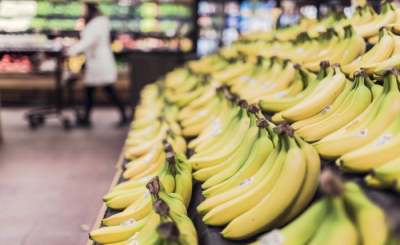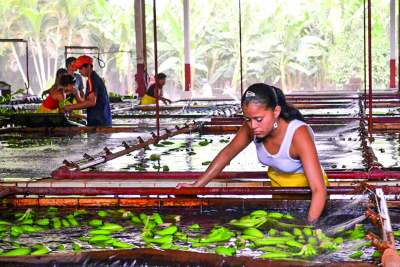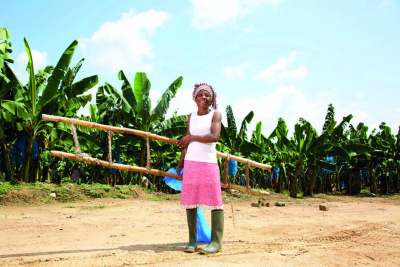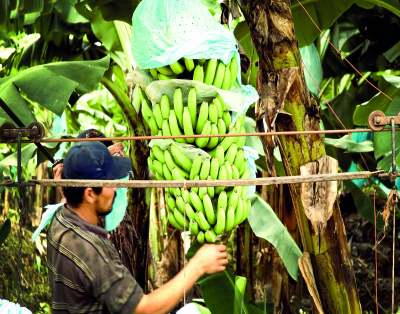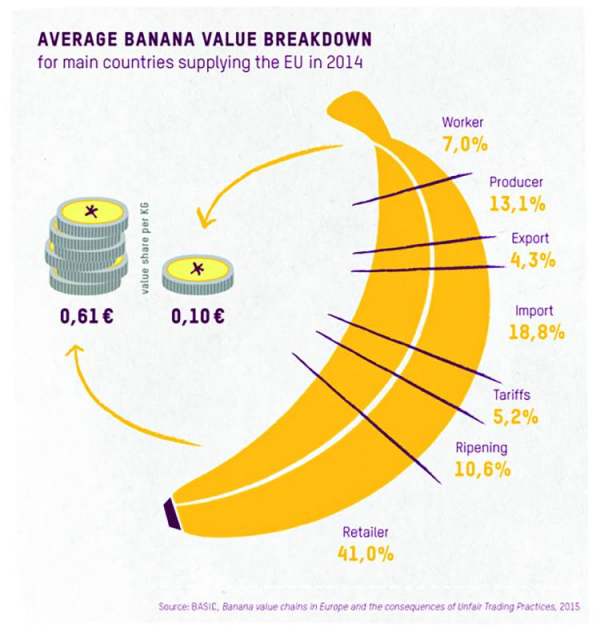Bananas and the environment
Carbon footprint
Despite being freighted from halfway across the world, bananas are a relatively lowcarbon food. They have a footprint of around 70gCO2e – a small figure in comparison to the energy and nutrients they provide.
This is because they are grown in natural sunlight, meaning no intensively heated greenhouses are used. They keep well, so are transported by boats rather than airfreight. And they require no packaging – because they provide their own.
| Food |
gCO2e/kcal |
| Apples |
0.34 |
| Oranges |
0.48 |
| Banana |
0.61 |
| Bread |
0.83 |
| Avocado |
1.23 |
| Berries/grapes |
3.00 |
| Milk chocolate |
4.28 |
| Dairy milk |
4.71 |
| Eggs |
4.77 |
| Tomatoes |
8.00 |
| Chicken |
8.30 |
| Beef |
60.24 |
The banana, though, also shows that environmental destruction is far more complex than just carbon counting.
Chemical bananas
The banana uses more agrochemicals than any other crop in the world, with the possible exception of cotton. In the highest rainfall areas, where disease pressure is the greatest, most farmers will spend more on chemicals than paying their workers. These chemicals seep into local water systems, causing eutrophication (the rapid growth of algae in water, sapping oxygen needed by other animals and plants) and destroying aquatic life.
As pests and diseases become exposed to more and more chemicals, they adapt to be more resistant – meaning that ever stronger pesticides and fungicides are developed. The polluted water is often used for drinking, cooking and washing.
Campaign group BananaLink says,
“For plantation workers and local people, the health impacts of extensive agrochemical use are numerous, ranging from depression and respiratory problems to cancer, miscarriages and birth defects.”
In Ecuador, of the 26 active pesticide ingredients used for banana production, 7 are banned in the EU and 18 are prohibited in Denmark. The director of a school for children with disabilities in Rícaurte, Ecuador told Oxfam,
“Almost all the parents of the children with disabilities at our school work on plantations or live nearby.”
In some countries, agrochemicals are applied aerially – dropped from planes over whole areas, including onto workers, their homes and their food. It is estimated that up to 85% of the chemicals sprayed by plane fail to land on crops.
Many countries, such has Ecuador, have ruled that workers should not be in the fields when spraying occurs. However, they often fail to enforce such laws. Banana workers, particularly women, often can’t afford to stay out of the fields, if it would mean losing the hours’ pay.
65% of the workers that Oxfam spoke to in 2016 said that they continued working during spraying.
Company agrochemical policies
None of the banana producers in this guide had any policies on the use of hazardous chemicals – with the exception of those selling Organic and Fairtrade. These certifications include controls on synthetic chemical use.
All other producers lost half a mark under Pollution & Toxics, Habitats & Resources and Workers’ Rights for the lack of policies:
Banacol, Chiquita, Del Monte, Dole, Favorita and Fyffes.
Monoculture
Monocultures – where a crop is only grown from a single variety – often lead to extensive agrochemical use. They degrade the soil, so that farmers rely on ever greater quantities of fertiliser. They are also highly vulnerable to pests, fungi and disease, and farmers will again rely on agrochemicals to keep the problem under control. A single disease or pest can wipe out the entire variety.
97% of bananas come from a single variety, the cavendish banana. In the 20th Century, the cavendish’s predecessor was decimated by the ‘Panama disease’, a fungus that destroyed plantations around the world. The cavendish was resistant. But experts warned that it would not stay this way long – as it too became a monoculture.
In recent decades, Panama disease has again been destroying plantations in Asia, Australia and Africa. Losses in the Philippines alone have been reported at US$44 million. In August 2019, the disease was found in Colombia, attacking cavendish plantations in Latin America for the first time and causing the country to declare a national emergency.
If not contained, the disease could leave thousands around the world without a vital source of sustenance and income.
GM bananas
Although not yet for sale, GM bananas resistant to the disease are being developed in response. This could bring with it a whole host of new problems and would not fundamentally address the monoculture issue – meaning that history could just repeat itself for a third time.
It is important to move away from monocultures and start producing a variety of bananas. But the transition is expensive for producers and is going to be difficult in the face of poor prices and the demand for perfect, identical fruit.

